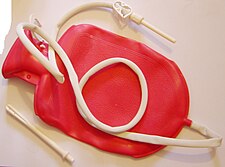Douche
| Douche | |
|---|---|
 A vaginal bulb syringe with lateral holes near the tip of the nozzle | |
| Pronunciation | /duːʃ/ |
| ICD-9-CM | 96.44 |
| MeSH | D044364 |
A douche is a device used to introduce a stream of water into the body for medical or hygienic reasons, or the stream of water itself. Douche usually refers to vaginal irrigation, the rinsing of the vagina, but it can also refer to the rinsing of any body cavity. A douche bag is a piece of equipment for douching—a bag for holding the fluid used in douching. To avoid transferring intestinal bacteria into the vagina, the same bag must not be used for an enema and a vaginal douche.
Douching after sexual intercourse is not a form of
Etymology
The word's first known use is in 1766.
Overview

Many health-care professionals state that douching is dangerous, as it interferes with both the vagina's normal self-cleaning and with the natural bacterial culture of the vagina, and it might spread or introduce infections. Douching is implicated in a wide variety of dangers, including: adverse pregnancy outcomes including
In May 2003, a randomized, controlled, multi-center study was conducted with 1827 women ages 18–44 who were regular users of a douche product and who had been treated recently for a sexually transmitted bacterial infection or bacterial vaginosis. Women were randomly assigned to use either a newly designed and marketed douche product or a soft cloth towelette. There was little or no indication of a greater risk of PID among women assigned to use the douche product (versus soft cloth towelette).[7]

Antiseptics used during douching disturb the natural balance of bacteria in the vagina and can cause infections.[8] Unclean douching equipment may introduce foreign bodies into the vagina. Douching may also wash bacteria into the uterus and fallopian tubes, causing fertility problems.[9] For these reasons, the practice of douching is now strongly discouraged except when ordered by a physician for medical reasons.[8]
Douching after intercourse is estimated to reduce the chances of conception by only about 30%.
A 1995 survey quoted in the University of Rochester study found that 27% of U.S. women age 15 to 44 douched regularly, but that douching was more common among African-American women (over 50%) than among white women (21%),[8] and frequent douching contributes to more frequent bacterial vaginosis among African-American women than the average.[4]
Medical doctor Harriet Hall writes that not only can douching change the pH of the vagina and lead to infections, "There is no need ... to cleanse the vagina. It cleanses itself".[12]
Slang uses
Douchebag and its variants, or simply douche,[13][14] are pejorative terms[14] referring to an arrogant, obnoxious, or despicable person.[15] The slang usage of the term originated in the 1960s.[16]
See also
References
- ISBN 9781573562553.
- S2CID 46715131.
- ^ "Douche – Definition and More from the Free Merriam-Webster Dictionary". Merriam-webster.com. 2012-08-31. Retrieved 2013-08-03.
- ^ a b Velasquez-Manoff, Moises (Jan 11, 2013). "What's in Your Vagina? A healthy microbiome, hopefully". Slate.
- S2CID 46715131.
- ^ "WebMD article on the causes of yeast infections, including douching". Women.webmd.com. 2011-10-31. Retrieved 2013-08-03.
- PMID 12859036.
- ^ JSTOR 4011204. Archived from the original(PDF) on September 26, 2012. Retrieved 1 March 2013.
- ^ "Warning from Kelly Shanahan, MD on douching". Health.ivillage.com. Archived from the original on 2007-11-11. Retrieved 2013-08-03.
- ^ Baird, Donna; Weinberg, Clarice (June 1996). Grigg, Bill (ed.). "NIH Study: Among Women Who Want to Get Pregnant, Douching May Delay Conception". American Journal of Public Health. Retrieved 2019-07-12 – via NIH.
- ^ Trussell J (2011). "Contraceptive Efficacy." (PDF). In Hatcher RA, Trussell J, Nelson AL, Cates W, Kowal D, Policar M (eds.). Contraceptive Technology (Twentieth Revised ed.). New York NY: Ardent Media. Archived from the original (PDF) on 2017-02-15. Retrieved 2019-07-13.
- ^ Hall, Harriet (2018). "The Care and Feeding of the Vagina". Skeptical Inquirer. 42 (5): 28–29.
- ^ "Define Douche at Dictionary.com". Dictionary.com. Retrieved 24 December 2015.
- ^ a b "douche – Dictionary Definition". Vocabulary.com. Retrieved 24 December 2015.
- ^ "Define Douchebag at Dictionary.com". Dictionary.com. Retrieved 24 December 2015.
- ^ "Terms of Derogation". Drbilllong.com. Archived from the original on 14 April 2006. Retrieved 2013-08-03.
External links
 Media related to Douches at Wikimedia Commons
Media related to Douches at Wikimedia Commons The dictionary definition of douche bag at Wiktionary
The dictionary definition of douche bag at Wiktionary- "Douching" Womenshealth.gov (archive from 24 October 2008)
- "Douching fact sheet" at Womenshealth.gov





